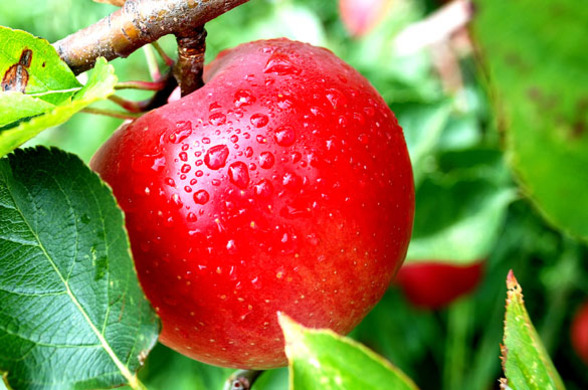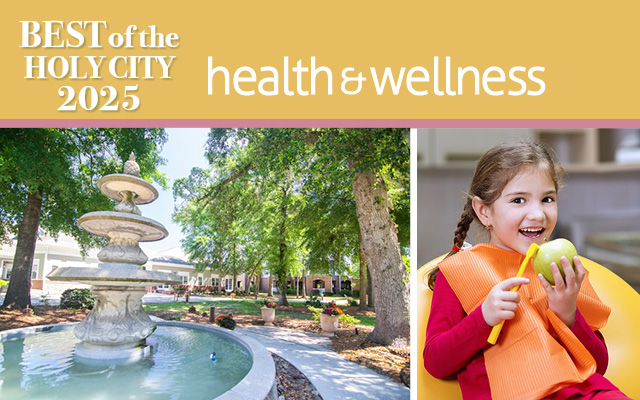An Apple A Day
29 Sep 2013
Heart-healthy, cancer-fighter, asthma deterrent and mouth cleanser. Plus, they make you smarter!
By Edna Cox Rice, RD, CSG, LD
Delicious and crunchy, apples are one of the most popular fruits. Today they seem commonplace compared to superfruits such as pomegranates or acai berries. Surprisingly, apples are loaded with nutritional benefits that justify the “apple a day” adage. So was Mom right?
Here are some of the nutritional boons of the Apple:
A is for apple and antioxidants. Apples are rich in antioxidant phytonutrients, flavonoids and polyphenols. Some of the important flavonoids in apples are Quercetin, Epicatechin and Tartaric Acid. It’s the Tartaric Acid that gives the tart flavor to them. Altogether these compounds provide protection from the deleterious effects of free radicals.
Apples are good for your Heart. Heart disease is the number one cause of death and a major cause of disability in the United States according to the National Institute of Health. Apples contain Pectin, a soluble fiber shown to be effective in lowering cholesterol. Apple skins contain polyphenols (powerful antioxidants) that also help your heart by lowering inflammation and keeping blood platelets from sticking together.
The flavonoids in apples work as antioxidants benefiting your heart because they stop the oxidation of LDL cholesterol – the “bad” cholesterol – and protect against hardening of the arteries. Several studies have shown that people who eat two apples a day may lower their cholesterol levels as much as 16 percent.
The antioxidant properties in apples are also known to curb cancer cell growth. Researchers from Cornell University found that the high flavonoid content found in apples is associated with decreased risk of several types of cancer, including liver, colon, and breast cancers. The compounds in apple peels are exceptionally high in antioxidants which help fight cancer cells by reducing their ability to grow and spread. To maximize apples anticancer benefits, be sure to eat the skin!
Along with soluble fiber, apples contain a good amount of insoluble fiber- which is important in maintaining a healthy digestive system. Insoluble fiber absorbs water and adds bulk that helps to keep things moving along your digestive tract. Apples and their skin contain both insoluble (pectin) and soluble fibers that also promote the growth of healthful bacteria within your digestive system. The fiber, pectin, helps to reduce the risks of colon cancer.
Quercetin, one of the abundant antioxidants in apples reduces the risks of asthma. Research has shown Quercetin also helps to improve lung function in healthy people as well as those having COPD.
Apples are anti-bacterial not only for your gut, but for your teeth and oral health as well. Eating an apple a day can help prevent tooth decay. Biting into an apple and chewing stimulates the production of saliva and helps clean your teeth and gums. Apples kill 80% of the bacteria in your mouth and are effective in warding off viruses.
Give your system a boost. The Vitamin C found in apples boosts and fortifies the immune system. Consuming foods rich in Vitamin C are effective in helping the body develop resistance against infections. Apples contain about 1000 mg of Vitamin C.
Good for your brain! Apples may make you smarter. Eating apples boost the production of acetylcholine, a chemical that transmits messages between nerve cells. This helps to keep the brain sharp as you age, enhance memory and lessen the odds of developing Alzheimer’s. The Quercetin also protects brain cells from free radical damage that may lead to Alzheimer’s Disease.
Apples are a good choice for a snack or dessert for diabetics. Since apples are a good source of fiber and they take time to eat . . . you gotta chew . . . this gives your body time to register itself full before consuming too many calories. The natural sugars enter the blood stream slowly. This helps to keep blood sugar and insulin levels steady. In the end you feel full longer. Apples are a low glycemic index food. The soluble fiber in apples is the key to blunting blood sugar swings.
This refreshing, juicy fruit is about 80% water. Eating apples actually contributes to your daily fluid intake. Or you can drink apple juice. The juice contains many of the same beneficial nutrients as the whole fruit itself. All you miss is the five or so grams of fiber.
Want to lose weight? Snack on an apple or have one for dessert. Apples are fat free, sodium free and low in calories! A typical apple has 70 – 100 calories. They contain no saturated fats or cholesterol. Apples also contain some calcium, iron, folate, Vitamin A and complex carbohydrates. A medium sized apple provides 4-6 grams of fiber, 20% of the recommended daily intake for fiber. Their high fiber and complex carbohydrate content help to fill you up and keep you feeling full longer.
Autumn is the best time of year for eating apples. There are at least 7,500 varieties. Here in South Carolina among the most popular varieties are Red Delicious, Gala, McIntosh, Granny Smith, Fuji and Golden Delicious. What apple you select depends on how you plan to use it. The best eating and favorite snack apples are the sweet and juicy Red Delicious variety. Granny Smith is a great choice if you enjoy a crisp, extremely tart flavor; they’re great for pies. Fuji apples tend to be sweeter with a spicy flavor. For homemade applesauce McIntosh apples are the best pick because of their softer flesh. A mix of any of these apples makes a perfect pie or apple crisp.
To reap the most healthful benefits apples should be eaten raw, leaving the peel on increases the benefits even more. Apple skin has 2 – 6 times the antioxidant content as the flesh. Hopefully you’ll go for the whole apple. But remember you need to wash the skin thoroughly to eliminate dirt and pesticides. Organic is always the safest and healthiest choice. Organic apples still need to be washed because of their handling in the grocery stores or markets so that you can enjoy the peel worry free.
Organic produce is more readily available at local grocery stores today. Farmers’ markets and local produce stands may offer organic selections; they always have locally grown produce which is the next best thing to organic. Fewer pesticides are used and there is less handling than with grocery store options. You can always “pick your own.” You can visit apple farms or orchards in the South Carolina Upstate and pick your apples straight off the tree. Go to Pickyourown.org to locate these farms and orchards. Enjoy one of the fall season’s healthiest and freshest pick!
Apple-Licious Snack and Dessert ideas!
In the mood for a little sweet thing? Try Apple Pie Slices – slice and seed apples; cut into slices; sprinkle with cinnamon. Tastes like apple pie without all the fat and calories!
Baked Apples cut off the top and core; sprinkle walnuts and brown sugar on top. Bake at 375’ until tender, about 45 minutes.
Cha Cha Cha Salsa makes about 2 cups
3 medium Red Delicious apples, cored and chopped
2 – 4 oz. cans diced Green Chiles
1/2c Raisins
1/2c thinly sliced Green Onions
1/3c Cider Vinegar
3 tablespoons Brown Sugar
¼ teaspoon Ground Cumin
Combine apples, chiles, raisins, vinegar, sugar and cumin in a medium bowl. Cover and chill at least 1 hour. Serve with chicken or pork.
Nutrition Information: 88 calories, 1 gram protein, 0 gram fat, 23 gram carbohydrate, 3 0 mg cholesterol, 6 mg sodium gram fiber
Apple Slices make yummy dippers for chocolate or caramel fondue. Tangy, zestier apples are great in cheese fondues.
Apples make a great Halloween Treat. Try them candied, with caramel sauce or decorate them as mini jack-o-lanterns.











